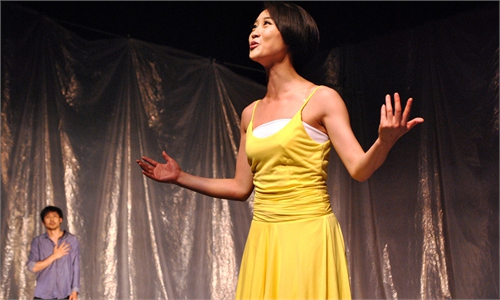ARTS / CULTURE & LEISURE
Poetry flows from BRICS to Great Wall

Illustration: Liu Xiangya/GT
"Finally, I got to know how silk is produced!" Russian poet Evgeniia Uliankina told me on her way to the Mutianyu section of the Great Wall along with her peers, delegates to the First International Youth Poetry Festival: Special Session for BRICS Countries."The silk farm was very interesting. I didn't know how they [ancient Chinese] made silk," she said. The curious poet recalled the moment when she saw and touched a silkworm in Haining, East China's Zhejiang Province.
Gaireyah Fredericks, a poet from South Africa, said that through the visit to Haining, she came to understand how the residents there were self-sufficient and made their own food and clothing.
Kicking off their tour in Hangzhou, East China's Zhejiang Province, the 72 poets traveled from Hangzhou to Beijing via high-speed railway.
On the way to the Mutianyu Great Wall, the shuttle bus was full of excitement. Uliankina said, "The Great Wall is one of the miracles in the world and we all got to know China because of the Great Wall."
As a comprehensive defense system, the Great Wall witnessed the ancient history of the country and its dynamic relations with other states. Today, so many poets from different countries got to visit this UNESCO World Heritage Site and share their poems in their own language. The sphere is all about peace and harmony.
On the Great Wall, Parvathy Salil, a poet from India, was busy taking pictures of a watch tower when she noticed the sculpture of animals on the edge of the roof.
Her curiosity for the symbolic meaning of the animals was expressed in her poem. She drafted three lines about the Great Wall:
"Locked within the secrets
of bricks, between secrets
of past world of glory"
She then explained a bit about her work to me.
"One of the things that really struck me is that this was built ages ago. How did the soldiers conquer this terrain? What technologies did they use to build it? How long did it take? Despite the weather conditions and all the constraints of this location, how did they manage to do this? There are so many secrets… It's splendid, it's beautiful, it's mysterious. It's got so many different walls with so many secrets that coexist."
Salil had been observing the ancient Chinese buildings throughout her trip. In China's Archaeological Ruins of Liangzhu City, a UNESCO World Heritage Site on the outskirts of Hangzhou, she learned that ancient Chinese used grass and mud between bricks to make buildings last longer, while at the Great Wall, she noticed the white parts between the bricks that interlock them. That's why in her new poem, the keyword was "secret."
The Taj Mahal in India is also a shining pearl in human civilization. People travel to different countries to appreciate the fruits of other civilizations. Thus each nation has its own pride.
After enjoying the marvelous views of the Great Wall, the 72 poets shared their own poems during a recital session on Tuesday. The backdrop read, "Both sides of the Great Wall," or wang changcheng nei wai in Chinese, which is a line from a poem written by Mao Zedong to describe a spectacular view of the Great Wall in freezing winter. According to the event organizer, the line was meant to trigger the poets' imaginations so they could "feel" the cold temperatures of northern China as snowflakes drift on both sides of the Great Wall.
The poets' tour actually took place during the hottest days in Beijing. With their shirts soaked with sweat, Brazilian poets told me that they felt the urge to collaborate and create more poems to raise people's awareness to cherish nature and learn from plants.
Thiago Ponce de Moraes and Julia de Carvalho Hansen, two poets from Brazil, compared the temperatures in their own country and China, mentioning that global warming turns out to be a common problem.
"Climate change is an emerging topic. We feel we have to do something to manage the situation," Ponce de Moraes said.
"There are things we need to learn from their [plants'] experience in the world, such as trees. It's very impressive, as where we have trees, it's cooler," Carvalho Hansen, who writes many poems about human beings' relationship with plants, said while taking a break in the shade.
We can't overload our planet by wasting resources, she said.
Ponce de Moraes agreed, "We should learn from nature. We are nature."
Meanwhile, Gautam Vegda, an Indian poet, told me that he finds it makes sense to make long-term efforts in creative collaboration.
"This festival is temporary, maybe six or seven days, but let's not forget it after going home. Let's get connected and collaborate more to establish harmony, love and compassion to the world, for a better life," he said.
He introduced that there is multilingualism in his own country, so he found it normal to listen to different languages from different countries during the special session.
Strolling on the Great Wall, Enock Shishenge, a poet and middle school teacher from South Africa, told me that he found it promising to start from cultural diversity and step up efforts to seek solutions to global problems through creative collaboration.
The author is a reporter with the Global Times. life@globaltimes.com.cn



